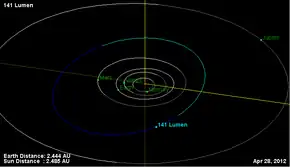 Orbital diagram | |
| Discovery[1] | |
|---|---|
| Discovered by | P. P. Henry |
| Discovery date | 13 January 1875 |
| Designations | |
| (141) Lumen | |
| Pronunciation | /ˈluːmən/,[2] /ˈluːmɛn/[3] |
Named after | Lumen: Récits de l'infini |
| main-belt · (middle) Eunomian interloper | |
| Orbital characteristics[1] | |
| Epoch 31 July 2016 (JD 2457600.5) | |
| Uncertainty parameter 0 | |
| Observation arc | 138.63 yr (50635 d) |
| Aphelion | 3.23723 AU (484.283 Gm) |
| Perihelion | 2.09253 AU (313.038 Gm) |
| 2.66488 AU (398.660 Gm) | |
| Eccentricity | 0.21477 |
| 4.35 yr (1589.0 d) | |
| 292.477° | |
| 0° 13m 35.623s / day | |
| Inclination | 11.8967° |
| 318.504° | |
| 58.1076° | |
| Physical characteristics | |
| Dimensions | 131.03±2.9 km[1] 130 km[4] 131.35 ± 5.21 km[5] |
| Mass | (8.25 ± 5.77) × 1018 kg[5] |
Mean density | 1.4 g/cm3 (estimate)[6] 6.95 ± 4.93 g/cm3[5] |
| 19.87 h (0.828 d)[1] 0.820 d (19.67 h)[7] | |
| 0.0540±0.002[1] 0.054[4] | |
| C | |
| 8.4 | |
Lumen (minor planet designation: 141 Lumen) is a carbonaceous asteroid from the intermediate asteroid belt, approximately 130 kilometers in diameter. It is an identified Eunomian interloper.
Description
It was discovered on January 13, 1875, by the brothers Paul Henry and Prosper Henry, but Paul is the one who was given the credit for this discovery. It is named for Lumen: Récits de l'infini, a book by the astronomer Camille Flammarion.[8]
Richard Binzel and Schelte Bus further added to the knowledge about this asteroid in a light-curve survey published in 2003. This project was known as Small Main-belt Asteroid Spectroscopic Survey, Phase II or SMASSII, which built on a previous survey of the main-belt asteroids. The visible-wavelength (0.435–0.925 micrometre) spectra data was gathered between August 1993 and March 1999.[9]
Lightcurve data has also been recorded by observers at the Antelope Hill Observatory, which has been designated as an official observatory by the Minor Planet Center.[10]
References
- 1 2 3 4 5 "141 Lumen". JPL Small-Body Database. NASA/Jet Propulsion Laboratory. Retrieved 12 May 2016.
- ↑ "lumen". Merriam-Webster.com Dictionary.
- ↑ "lumen". Oxford English Dictionary (Online ed.). Oxford University Press. (Subscription or participating institution membership required.)
- 1 2 Supplemental IRAS Minor Planet Survey Archived June 23, 2006, at archive.today
- 1 2 3 Carry, B. (December 2012). "Density of asteroids". Planetary and Space Science. 73 (1): 98–118. arXiv:1203.4336. Bibcode:2012P&SS...73...98C. doi:10.1016/j.pss.2012.03.009. See Table 1.
- ↑ See Georgij A. Krasinsky et al. Hidden Mass in the Asteroid Belt, Icarus, Vol. 158, p. 98 (2002), for density estimates
- ↑ PDS lightcurve derived data
- ↑ Schmadel Lutz D. Dictionary of Minor Planet Names (fifth edition), Springer, 2003. ISBN 3-540-00238-3.
- ↑ Bus, S., Binzel, R. P. Small Main-belt Asteroid Spectroscopic Survey, Phase II. EAR-A-I0028-4-SBN0001/SMASSII-V1.0. NASA Planetary Data System, 2003.
- ↑ "Lightcurve Results". Archived from the original on 25 July 2011. Retrieved 9 March 2008.
External links
- Lightcurve plot of (141) Lumen Archived 5 February 2023 at the Wayback Machine, Antelope Hills Observatory
- 141 Lumen at AstDyS-2, Asteroids—Dynamic Site
- 141 Lumen at the JPL Small-Body Database